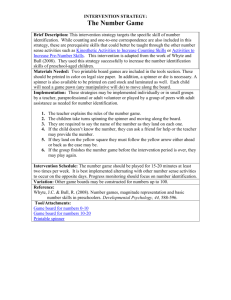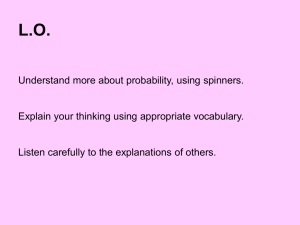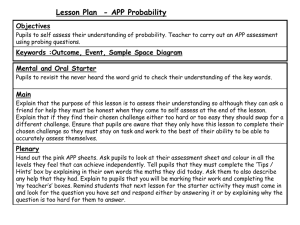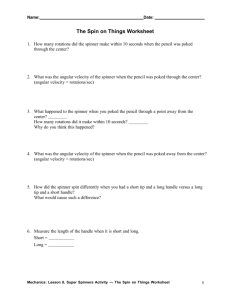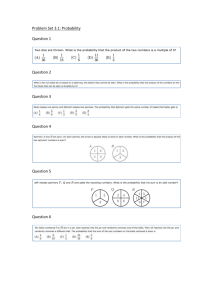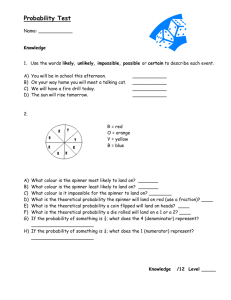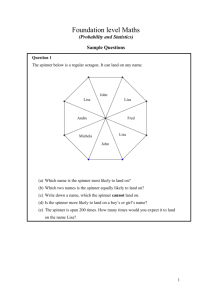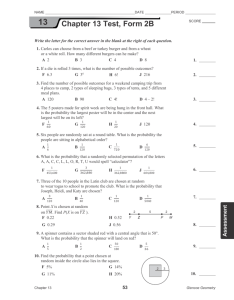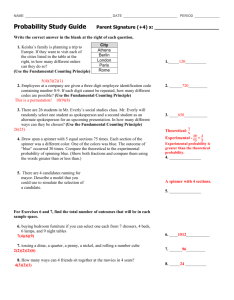Probability spinners
advertisement
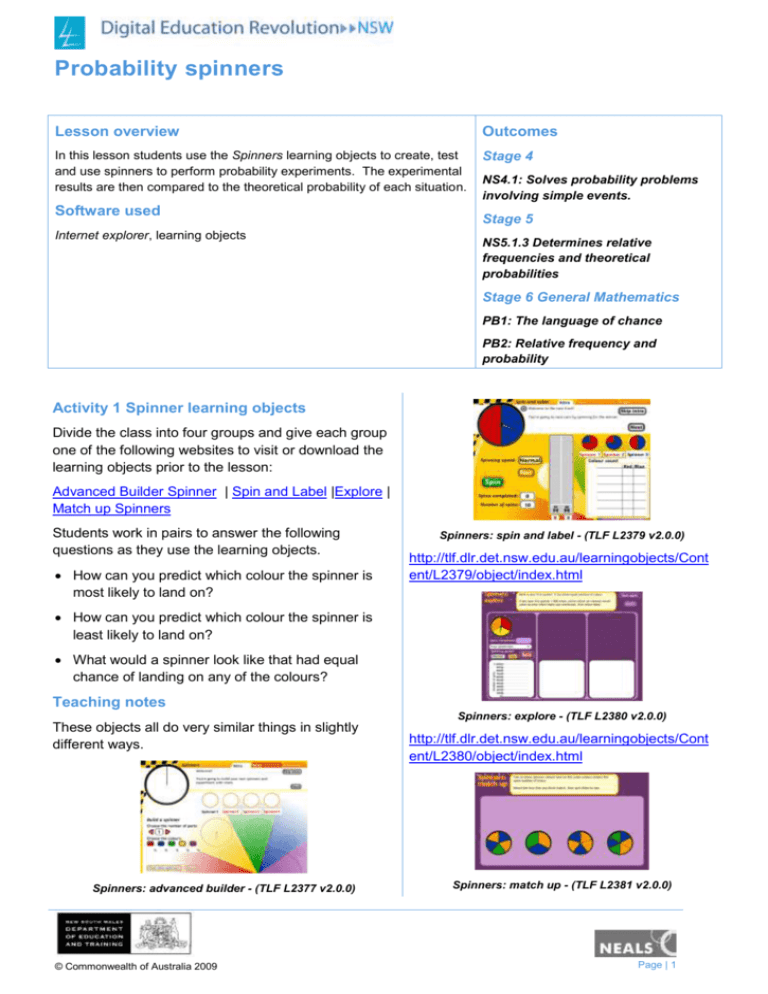
Probability spinners Lesson overview Outcomes In this lesson students use the Spinners learning objects to create, test and use spinners to perform probability experiments. The experimental results are then compared to the theoretical probability of each situation. Stage 4 Software used Internet explorer, learning objects NS4.1: Solves probability problems involving simple events. Stage 5 NS5.1.3 Determines relative frequencies and theoretical probabilities Stage 6 General Mathematics PB1: The language of chance PB2: Relative frequency and probability Activity 1 Spinner learning objects Divide the class into four groups and give each group one of the following websites to visit or download the learning objects prior to the lesson: Advanced Builder Spinner | Spin and Label |Explore | Match up Spinners Students work in pairs to answer the following questions as they use the learning objects. How can you predict which colour the spinner is most likely to land on? Spinners: spin and label - (TLF L2379 v2.0.0) http://tlf.dlr.det.nsw.edu.au/learningobjects/Cont ent/L2379/object/index.html How can you predict which colour the spinner is least likely to land on? What would a spinner look like that had equal chance of landing on any of the colours? Teaching notes Spinners: explore - (TLF L2380 v2.0.0) These objects all do very similar things in slightly different ways. Spinners: advanced builder - (TLF L2377 v2.0.0) © Commonwealth of Australia 2009 http://tlf.dlr.det.nsw.edu.au/learningobjects/Cont ent/L2380/object/index.html Spinners: match up - (TLF L2381 v2.0.0) Page | 1 http://tlf.dlr.det.nsw.edu.au/learningobjects/Content/L2 377/object/index.html http://tlf.dlr.det.nsw.edu.au/learningobjects/Cont ent/L2381/object/index.html Activity 2 Theoretical vs relative Explain the concept of calculating the theoretical probability of an event using the learning objects as examples. Discuss the difference between the theoretical probability of an event and the relative probability of an event. Ask your students to complete the Predict and Test, Mystery Spinner or Snakes and Spinners: Assessment learning objects. Students may write up a report of their findings. Those students familiar with web blogs could post their explanations of calculating theoretical probability and the difference between theoretical and relative probability and then pose a challenge question for other students to answer. For example, What is the theoretical probability of rolling two 6's on a pair of dice? (Hint: Use Predict and Test) Snakes and spinners: assessment - (TLF L8868 v1.0.0) http://tlf.dlr.det.nsw.edu.au/learningobjects/Cont ent/L8868/object/index.html Activity 3 Bias spinners This site <http://illuminations.nctm.org/ActivityDetail.aspx ?ID=79> has a spinner where the sections can be adjusted so that not all parts are equal. Students can click on the + button next to the word Exploration and work through the activities. Discuss with the students how the percentages were calculated for each of the sectors. Have your students create and test their own spinner using cardboard and a paper clip. Challenge students to create spinners based on unusual percentage chances of particular colours winning. Spinners: predict and test - (TLF L2378 v2.0.0) http://tlf.dlr.det.nsw.edu.au/learningobjects/Content/L2 378/object/index.html Mystery spinner - (TLF L2382 v1.0.0) http://tlf.dlr.det.nsw.edu.au/learningobjects/Content/L2 382/object/index.html © Commonwealth of Australia 2009 Page | 2 Activity 4 What’s in a game? Activity 5 Design a spinner game This site <http://media.emgames.com/emgames/demosite/play demo.html?activity=M1A042&activitytype=dcr> has a very boring game which uses a spinner. Students, in pairs, design a spinner game which makes use of their knowledge of probability and covers the criteria below: Players must pay tokens to play the game The aim of the game is to win the most tokens Players must use their knowledge of probability to win tokens by playing the game Game 1 This site <http://www.learnalberta.ca/content/mejhm/html/object _interactives/probability/use_it.html> has a much more interesting game using a spinner. Game 2 Students, in pairs, play both games. Game 2 involves the students answering questions on spinner probability before they get to spin. Compare and contrast game 1 and game 2. © Commonwealth of Australia 2009 Page | 3
